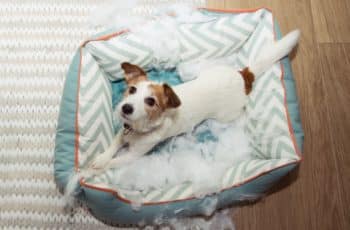Most dogs like to dig, even when they are puppies. Some breeds might dig more than others, but usually it’s something every pup does as a matter of instinct.
As it is instinctual, trying to stop a dog digging can not only be a losing battle, but it might also cause them frustration and distress.
However, if they dig indoors it can cause you frustration and distress as you watch your carpets, walls, floors, couches and more get disheveled and destroyed as a result.
Providing your dog with an alternative way to dig indoors can be the answer to the problem, and doing so can also be an excellent way to provide the indoor enrichment that every dog needs – from when they are very young puppies – for them to stay happy and healthy.
Why Do Dogs Dig?
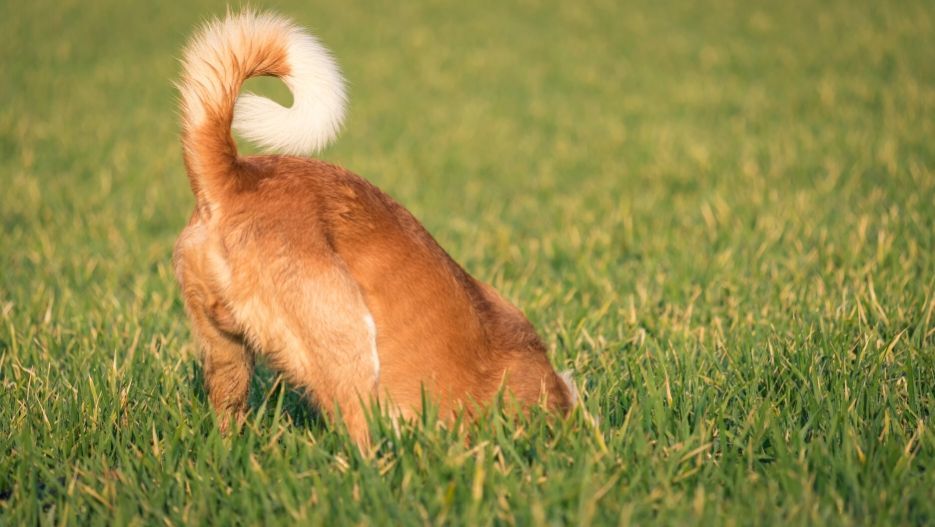
For dogs, digging is a normal intuitive habit. Dogs dig for a variety of reasons that date back to their ancestors in nature.
A wild dog would dig dens to keep their young secure and warm. Sleeping in a den protected them and their young pups from attackers and harsh temperatures and as a result lots of modern, domesticated dogs have a strong desire to sleep in or under den-like structures.
They frequently dig and circle the earth before lying down, as though trying to create a den-like resting place. Many dogs do the same thing on the carpet, furniture, or their own dog bed.
Digging is also used by dogs to keep warm or cool, to alleviate boredom, to bury valuable items such as bones, chews or toys. To them, it’s all perfectly acceptable, and they might have a hard time understanding why you get mad when they dig inside!
Although almost every dog will dig as a matter of instinct, some dog breeds are more likely to be ‘diggers’ than others. These breeds include all the following:
- Terriers
- Beagles
- Basset Hounds
- Collies
- Dachshunds
- Schanuzers
- Huskies.
If your puppy, or adult dog, has a tendency to dig indoors, whether they belong to one of these breeds or not, for the sake of your home it’s almost certainly behavior you want to control, even if it can’t quite be curtailed completely.
Enrichment activities can be a very effective way to do so – far more effective than shouting and other punishments – while also offering your pup, and you, lots of other benefits too.
What is Canine Enrichment?
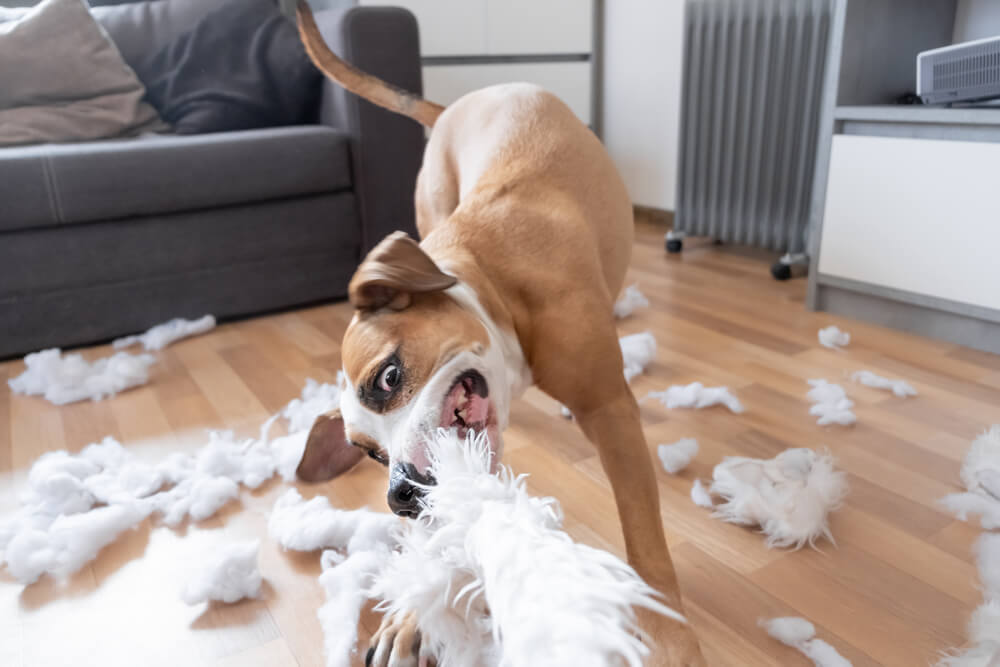
A bored or frustrated dog may take out its frustrations through chewing.
As a pet parent you may have seen or heard discussions or mentions of canine enrichment, or enrichment for dogs, recently as it’s a much buzzed about topic right now. However, you might not know quite what the term means or why it’s important.
Simply put, canine enrichment entails involving your dog in activities that will both challenge their minds and keep them physically active.
Canine enrichment is important not only because it promotes your dog’s physical and mental health and development, but also because it enhances your bond with your pet.
It also alleviates boredom. This reduces the possibility of aggressive behavior in dogs, which usually manifests itself as excessive chewing and constant barking.
It can also channel that natural desire to dig into something positive rather than something that wreaks havoc on your home and frays your temper.
5 Great Indoor Enrichment Ideas For Dogs That Like To Dig
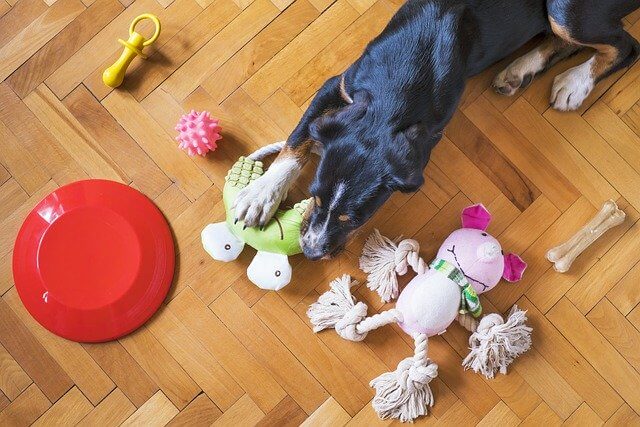
Mathew Coulton / Unsplash
Once you understand why your pup digs, both indoors and out, and the importance of enrichment for dogs, even young puppies, you are probably keen to start providing enrichment for your pup that will help rechannel his digging energies and help keep his mind and body healthy.
But how?
As a number of canine enrichment specialists point out, trying to get rid of digging behaviors altogether is unlikely to work, but creating enriching digging activities that will keep you both happy almost certainly will.
To help you get started, here are five indoor enrichment ideas for dogs who like to dig you can try out with your pup, many of which are not complicated or expensive
1.Build a Dog Ball Pit

Shop This Product
If you have the space indoors, providing your dog with a ball pit of his own can be a very effective way to rechannel his digging energies into something more productive, and is a suggestion that many experts make.
You can enhance his enjoyment of the ball pit – which most puppies will instinctively love anyway – by adding treats to the ball pile, as this will help reward him for digging in the right place!
If you do plan to build a dig pit for your pup, ensure that the balls you use are dog safe – that they won’t crack or splinter easily, which is the case for some thin plastic balls, and that the pit itself is sturdy and free of sharp edges. A heavy-duty toddler pool can be a good choice, as can a more dog specific option like this one.
2. Snuffle Mats

Shop This Product
Snuffle mats are a great tool for canine enrichment in general, and for diggers specifically. You can find lots of great premade options for sale in pet stores or online, or you can choose to make one of your own, as this Youtube video demonstrates:
3. Hide a Toy Dog Toys
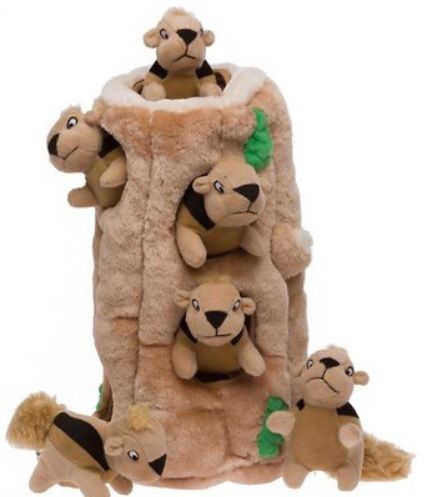
Outward Hound Hide A Squirrel Plush Dog Toy
Shop This Product
Another great dog toy for dogs who like to dig is a ‘hide a toy’ option like the Outward Hound Hide A Squirrel Plush Dog Toy. This toy features a ‘tree trunk’ – really a soft, pet-safe tube – and several plush toy squirrels.
The idea is that you place the squirrels into the tree trunk, and it’s then up to your pup to figure out how to get them out. This can be challenging for most dogs, and those who like to dig won’t ruin anything that’s ‘yours’while also indulging what really is a natural behavior. As a bonus, your pup can head off to sleep with one of his new ‘captives’ once the game is over and he is ready for a nap
4. Digging Puzzle Toys
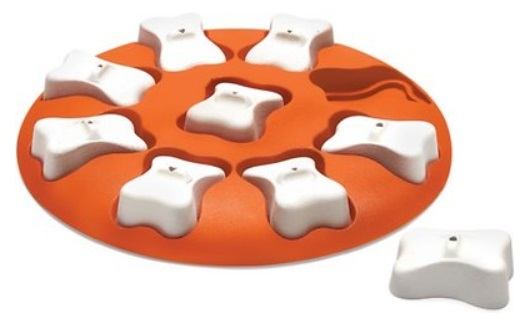
Outward Hound Nina Ottosson Dog Interactive Puzzle Dog Toy
Shop This Product
Puzzle toys are another growing category in pet stores, and some are specifically geared towards channeling digging behaviors.
A puzzle feeder like the Outward Hound Nina Ottosson Dog Interactive Puzzle Dog Toy can be an excellent choice as a pup must paw and ‘dig’ to get to the food ‘hidden’ under the various slots.
Such feeders can also help control the eating habits of puppies (and adult dogs) who eat too fast, something that can be very bad for their health.
5. Take a Dig Friendly Walk

The chances are that if you walk your dog to the local dog park digging it up will be something that’s frowned upon. Take them out to a less structured area, however, and it’s less of a problem.
Just try to ensure that your pup does not make too much of a mess and that you fill in any deep holes.
If there really is no outdoor space near you suitable for a ‘dig friendly walk’, but you do have some space in a backyard, a simple sandpit can serve as a great dig spot at the end of a walk, and it will be even more fun for your pup if it contains treats or toys they can hunt for.
Designating a dig spot outside may also help save your flowers and shrubs from destruction too, another plus!
Other great pet reads you’ll love:
Featured image by Via Flickr/sgilsdorf


